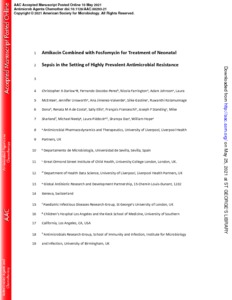Darlow, CA;
Docobo-Perez, F;
Farrington, N;
Johnson, A;
McEntee, L;
Unsworth, J;
Jimenez-Valverde, A;
Gastine, S;
Dona, RK;
de Costa, RMA;
et al.
Darlow, CA; Docobo-Perez, F; Farrington, N; Johnson, A; McEntee, L; Unsworth, J; Jimenez-Valverde, A; Gastine, S; Dona, RK; de Costa, RMA; Ellis, S; Franceschi, F; Standing, JF; Sharland, M; Neely, M; Piddock, L; Das, S; Hope, W
(2021)
Amikacin Combined with Fosfomycin for Treatment of Neonatal Sepsis in the Setting of Highly Prevalent Antimicrobial Resistance.
Antimicrob Agents Chemother, 65 (7).
ISSN 1098-6596
https://doi.org/10.1128/AAC.00293-21
SGUL Authors: Sharland, Michael Roy
![[img]](https://openaccess.sgul.ac.uk/113279/1.hassmallThumbnailVersion/Antimicrobial%20Agents%20and%20Chemotherapy-2021-Darlow-AAC.00293-21.full.pdf)  Preview |
|
PDF
Accepted Version
Available under License ["licenses_description_publisher" not defined].
Download (1MB)
| Preview
|
Abstract
Antimicrobial resistance (particularly by extended spectrum β-lactamase and aminoglycoside modifying enzyme production) in neonatal sepsis is a global problem, particularly in low- and middle-income countries, causing significant mortality. High rates of resistance are reported for the current WHO-recommended first-line antibiotic regimen for neonatal sepsis; ampicillin and gentamicin. We assessed the utility of fosfomycin and amikacin as a potential alternative regimen to be used in settings of increasingly prevalent antimicrobial resistance.The combination was studied in a 16 arm dose ranged hollow-fiber infection model (HFIM) experiment. The combination of amikacin and fosfomycin enhanced bactericidal activity and prevented emergence of resistance compared to monotherapy of either antibiotic. Modelling of the experimental quantitative outputs and data from checkerboard assays, indicated synergy.We further assessed the combination regimen at clinically relevant doses in HFIM with nine Enterobacterales strains with high fosfomycin/amikacin MICs and demonstrated successful kill to sterilisation in 6/9 strains. From these data, we propose a novel combination breakpoint threshold for microbiological success for this antimicrobial combination against Enterobacterales - MICF * MICA < 256 (where MICF and MICA are MICs for fosfomycin and amikacin). Monte Carlo simulations predict that a standard fosfomycin/amikacin neonatal regimen will achieve a >99% probability of pharmacodynamic success for strains with MICs below this threshold.We conclude that the combination of fosfomycin with amikacin is a viable regimen for the empiric treatment of neonatal sepsis and is suitable for further clinical assessment in a randomised controlled trial.
Statistics
Item downloaded times since 25 May 2021.
Actions (login required)
 |
Edit Item |



